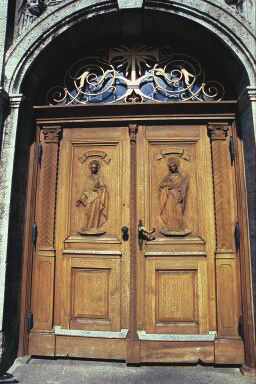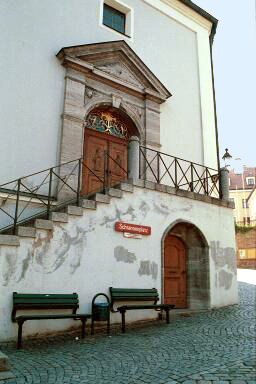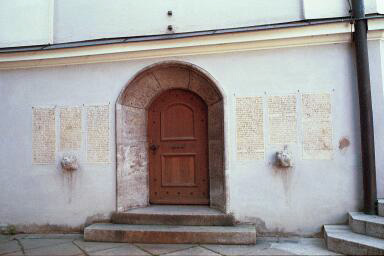Parish church of St. Jakob Dachau is a Catholic town, as are most of the other cities and towns in Bavaria. The Catholic parish church of St. Jakob is the most stunning building in the charming town of Dachau. The photograph above shows the view of the church from the hill where you climb up to the Castle. On the far left of the photograph, you can see the emblem of the Dachau Regional Museum, which depicts a man and a woman wearing the traditional regional clothing of Dachau. To the right of the church is another Baroque building which now houses Dachau's Office of Cultural Affairs. This beautiful church was built in the years 1624 to 1625 by Master-builder Hans Krumpper, and the Baroque tower was added in the years 1676 to 1678. The octagonal tower is 44 meters high and can be seen from anywhere in the town. The church is named after the apostle St. James, whose name is St. Jakob in German. The photograph below shows the door at the side entry to the church. Note that the door handle is shaped like a fish.  When the first German concentration camp was opened in March 1933 east of the town of Dachau, the parish priest of St. Jakob's church volunteered to say Mass for the prisoners in one of the barracks. He continued to say Mass and hear confessions at the camp until August 1936. By that time the Nazis were becoming increasingly hostile to the Catholic Church and many priests had been imprisoned in the Dachau concentration camp. The German priests were allowed to say Mass in their barrack. The Nazis also banned Catholic associations, but members of the former associations met secretly in the "catacombs" under the parish church of St. Jakob. Since Dachau is built on a hill, it has many underground passages including the one under the church. The photograph below shows the side entrance to St. Jakob's with the door shown in the photograph above. The lower door is the entrance into the "catacombs."  The photograph below shows the wall at the bottom of the steps leading down from the side door, shown in the photograph above. The names of the soldiers from the town of Dachau who died in the two World Wars is posted on the wall. There are six tablets on the wall with the names of 168 men who died at the front in World War I and 504 men who sacrificed their lives for their country in World War II. This sad sight is something that you see on the walls of small town Catholic churches all over Germany, not just in Dachau.  The photograph below shows the war memorial next to the church which honors the Dachau men who lost their lives fighting for the Fatherland in two World Wars. Designed by Karl Kroher, a Munich sculptor, the monument was dedicated in 1929. The statue on top is that of St. Sebastian. On the base of the column, there is an inscription in German which reads: "To protect Dachau and you, the heroes went to battle. We offer them our thanksgiving. So great was their sacrifice." In front of the memorial is Schrannen square where the Nazis used to gather to honor the fallen soldiers of World War I on the German Memorial Day. Behind the memorial, there is some construction going on, and behind that is the Hörhammer department store, which had an air-raid shelter in the basement during World War II.  From 1942 until the end of the war, the parish of St. Jakob organized a large-scale project to send food packages to the prisoners at the Dachau concentration camp. Farmers and business owners in Dachau donated food and medicine to the prisoners, which the SS allowed them to send to the camp. In the last days of the war, the Nazis released many of the clergymen in the camp a few weeks before the American Seventh Army arrived to liberate the camp. The German and Austrian priests who were released from the camp on March 27, 1945 came to the parish church of St. Jakob's where they were cared for until they were strong enough to get back to their homes. Interior of ChurchBack to List of Historic PlacesBack to Table of ContentsBack to Dachau indexHome |